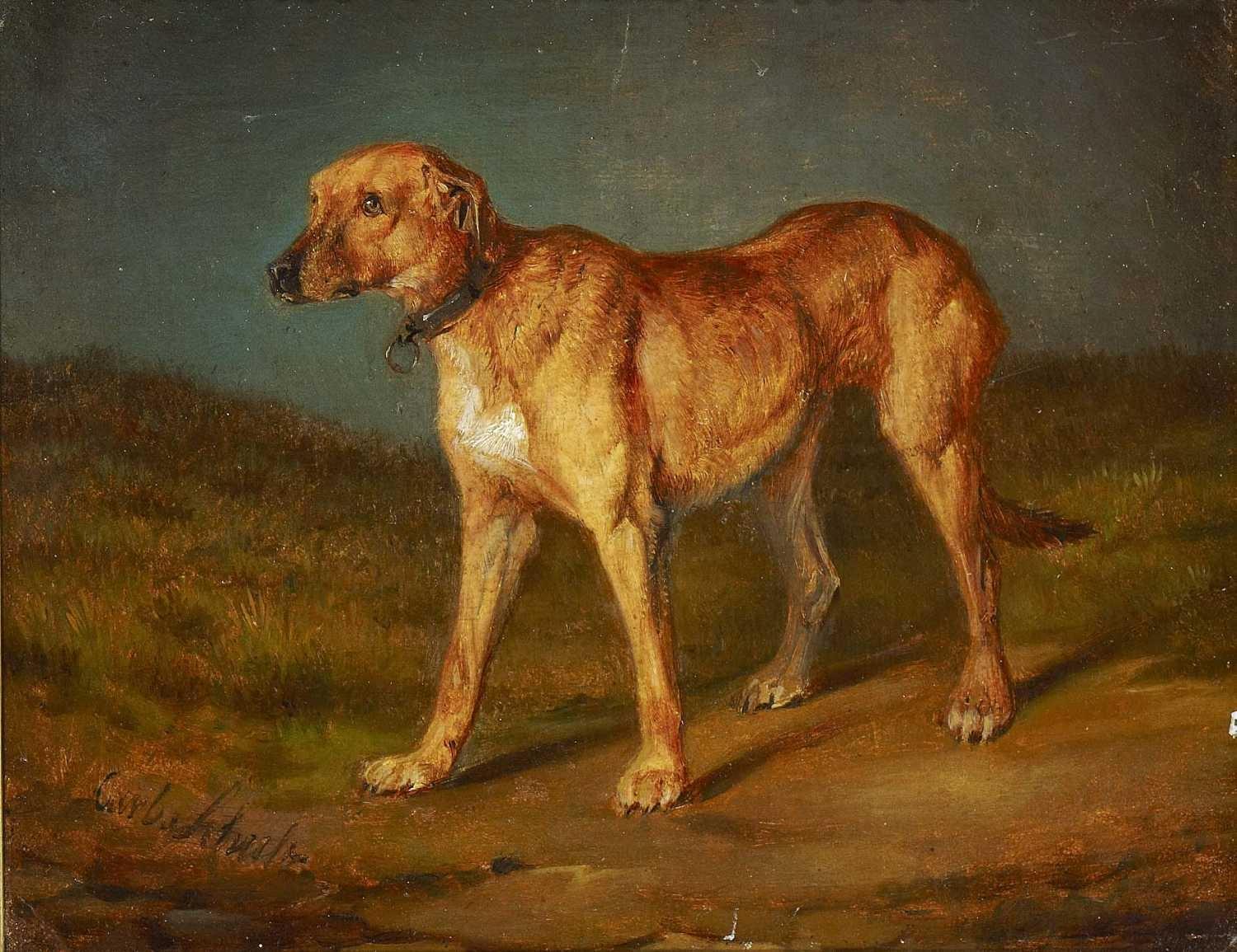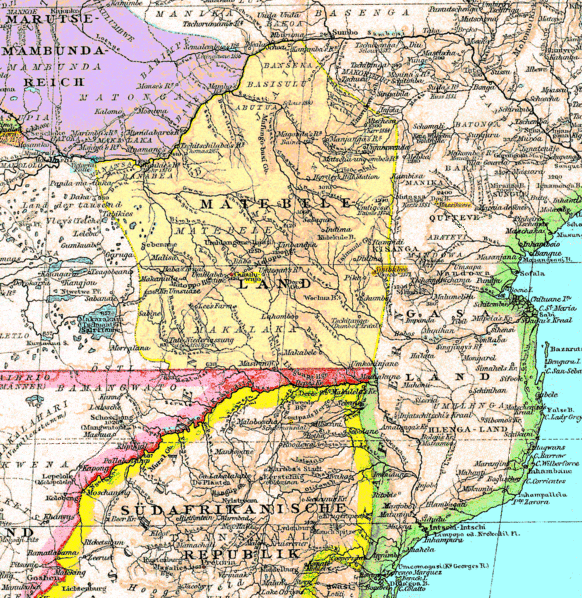|
Rhodesian Ridgeback
The Rhodesian Ridgeback is a large dog breed bred in the Southern Africa region. Its forebears can be traced to the semi-domesticated ridged hunting and guardian dogs of the Khoikhoi. These were interbred with European dogs by the early colonists of the Cape Colony of southern Africa. The original breed standard was drafted by F. R. Barnes, in Bulawayo, Southern Rhodesia (now Zimbabwe), in 1922, and approved by the South African Kennel Union in 1927. The Rhodesian Ridgeback at present is the only registered breed indigenous to Southern Africa. History The Khoikhoi people who lived the Cape Peninsula when the Dutch began trading with the area during the mid 17th century, had a semi-wild hunting dog which was described by Europeans as absolutely fearless and ferocious when acting as a guard dog. This dog measured approximately at the withers, with a lean but muscular frame. The ears have been described both as erect but later described as hanging due to interbreeding wi ... [...More Info...] [...Related Items...] OR: [Wikipedia] [Google] [Baidu] |
Kennel Union Of Southern Africa
The Kennel Union of Southern Africa (formerly the South African Kennel Club and the South African Kennel Union) is the official kennel club of South Africa. The club was founded as the South African Kennel Club in 1891 when the Southern African Kennel Club of Port Elizabeth formed an affiliation with the South African Kennel Club of Cape Town. The first documented dog show in South Africa took place in 1883 at the Albany Agricultural Show; the Port Elizabeth club was founded a week later, and the Cape Town club was founded in 1889. The Transvaal kennel club joined in 1894 and at a meeting in 1895 the kennel clubs of Cradock, East London and Grahamstown joined, Natal joined in 1899 and the Free State in 1905. In 1920 the club reorganised and changed its name to the South African Kennel Union, with the affiliation of the kennel clubs of Rhodesia and South West Africa in 1964 the club adopted its present name, the Kennel Union of Southern Africa. Initially the club maintained ... [...More Info...] [...Related Items...] OR: [Wikipedia] [Google] [Baidu] |
Lobengula
Lobengula Khumalo (c. 1845 – presumed January 1894) was the second and last official king of the Northern Ndebele people (historically called Matabele in English). Both names in the Ndebele language mean "the men of the long shields", a reference to the Ndebele warriors' use of the Nguni shield. Background The Matabele were descendants of a faction of the Zulu people who fled north during the reign of Shaka following the '' mfecane'' ("the crushing") or ''difaqane'' ("the scattering"). Shaka's general, Mzilikazi led his followers away from Zulu territory after a falling-out. In the late 1830s, they settled in what is now called Matabeleland in western Zimbabwe, but they claimed sovereignty over a much wider area. Members of the tribe had a privileged position against outsiders whose lives were subject to the will of the king. In return for their privileges, however, the Ndebele people both men and women had to submit to a strict discipline and status within the hierarch ... [...More Info...] [...Related Items...] OR: [Wikipedia] [Google] [Baidu] |
Northern Cape Province
The Northern Cape is the largest and most sparsely populated province of South Africa. It was created in 1994 when the Cape Province was split up. Its capital is Kimberley. It includes the Kalahari Gemsbok National Park, part of the Kgalagadi Transfrontier Park and an international park shared with Botswana. It also includes the Augrabies Falls and the diamond mining regions in Kimberley and Alexander Bay. The Namaqualand region in the west is famous for its Namaqualand daisies. The southern towns of De Aar and Colesberg found within the Great Karoo are major transport nodes between Johannesburg, Cape Town and Port Elizabeth. Kuruman can be found in the north-east and is known as a mission station. It is also well known for its artesian spring and Eye of Kuruman. The Orange River flows through the province of Northern Cape, forming the borders with the Free State in the southeast and with Namibia to the northwest. The river is also used to irrigate the many vineyards ... [...More Info...] [...Related Items...] OR: [Wikipedia] [Google] [Baidu] |
Kimberley, Northern Cape
Kimberley is the capital and largest city of the Northern Cape province of South Africa. It is located approximately 110 km east of the confluence of the Vaal and Orange Rivers. The city has considerable historical significance due to its diamond mining past and the siege during the Second Anglo-Boer war. British businessmen Cecil Rhodes and Barney Barnato made their fortunes in Kimberley, and Rhodes established the De Beers diamond company in the early days of the mining town. On 2 September 1882, Kimberley was the first city in the Southern Hemisphere and the second in the world after Philadelphia, Pennsylvania in the United States to integrate electric street lights into its infrastructure. The first stock exchange in Africa was built in Kimberley, as early as 1881. History Discovery of diamonds In 1866, Erasmus Jacobs found a small brilliant pebble on the banks of the Orange River, on the farm ''De Kalk'' leased from local Griquas, near Hopetown, which was his ... [...More Info...] [...Related Items...] OR: [Wikipedia] [Google] [Baidu] |
Matabeleland
Matabeleland is a region located in southwestern Zimbabwe that is divided into three provinces: Matabeleland North, Bulawayo, and Matabeleland South. These provinces are in the west and south-west of Zimbabwe, between the Limpopo and Zambezi rivers and are further separated from Midlands by the Shangani River in central Zimbabwe. The region is named after its inhabitants, the Ndebele people who were called "Amatabele"(people with long spears - Mzilikazi 's group of people who were escaping the Mfecani wars). Other ethnic groups who inhabit parts of Matabeleland include the Tonga, Bakalanga, Venda, Nambya, Khoisan, Xhosa, Sotho, Tswana, and Tsonga. The population of Matabeleland is just over 20% of the Zimbabwe's total. The capital and largest city is Bulawayo, other notable towns are Plumtree, Victoria Falls, Beitbridge, Lupane, Esigodini, Hwange and Gwanda. The land is fertile but semi arid. This area has coal and gold deposits. Industries include gold a ... [...More Info...] [...Related Items...] OR: [Wikipedia] [Google] [Baidu] |
Western Cape Province
The Western Cape is a province of South Africa, situated on the south-western coast of the country. It is the fourth largest of the nine provinces with an area of , and the third most populous, with an estimated 7 million inhabitants in 2020. About two-thirds of these inhabitants live in the metropolitan area of Cape Town, which is also the provincial capital. The Western Cape was created in 1994 from part of the former Cape Province. The two largest cities are Cape Town and George. Geography The Western Cape Province is roughly L-shaped, extending north and east from the Cape of Good Hope, in the southwestern corner of South Africa. It stretches about northwards along the Atlantic coast and about eastwards along the South African south coast (Southern Indian Ocean). It is bordered on the north by the Northern Cape and on the east by the Eastern Cape. The total land area of the province is , about 10.6% of the country's total. It is roughly the size of England or the St ... [...More Info...] [...Related Items...] OR: [Wikipedia] [Google] [Baidu] |
Swellendam
Swellendam is the fifth oldest town in South Africa (after Cape Town, Stellenbosch, Simon's Town, and Paarl), a town with 17,537 inhabitants situated in the Western Cape province. The town has over 50 provincial heritage sites, most of them buildings of Cape Dutch architecture. Swellendam is situated on the N2, approximately 220 km from both Cape Town and George. History Early travellers and explorers who visited the Cape in the 16th century traded with the Khoikhoi people who lived on these shores and in the interior. When the Dutch East India Company established a replenishment station at the Cape in 1652, trade continued inland as far as Swellendam. In 1743 Swellendam was declared a magisterial district, the third-oldest in South Africa, and was named after Governor Hendrik Swellengrebel, the first South African born Governor, and his wife, Helena Ten Damme. This outlying settlement soon became a gateway to the interior, and was visited by many famous explore ... [...More Info...] [...Related Items...] OR: [Wikipedia] [Google] [Baidu] |
Suurbraak
Suurbraak is a settlement in Overberg District Municipality in the Western Cape province of South Africa. The village was established in 1812, when the London Missionary Society established a mission station to serve the Attaqua Khoikhoi Khoekhoen (singular Khoekhoe) (or Khoikhoi in the former orthography; formerly also '' Hottentots''"Hottentot, n. and adj." ''OED Online'', Oxford University Press, March 2018, www.oed.com/view/Entry/88829. Accessed 13 May 2018. Citing G. S. .... References {{Overberg District Municipality Populated places in the Swellendam Local Municipality Populated places established in 1812 ... [...More Info...] [...Related Items...] OR: [Wikipedia] [Google] [Baidu] |
London Missionary Society
The London Missionary Society was an interdenominational evangelical missionary society formed in England in 1795 at the instigation of Welsh Congregationalist minister Edward Williams. It was largely Reformed in outlook, with Congregational missions in Oceania, Africa, and the Americas, although there were also Presbyterians (notable for their work in China), Methodists, Baptists, and various other Protestants involved. It now forms part of the Council for World Mission. Origins In 1793, Edward Williams, then minister at Carr's Lane, Birmingham, wrote a letter to the churches of the Midlands, expressing the need for interdenominational world evangelization and foreign missions.Wadsworth KW, ''Yorkshire United Independent College -Two Hundred Years of Training for Christian Ministry by the Congregational Churches of Yorkshire'' Independent Press, London, 1954 It was effective and Williams began to play an active part in the plans for a missionary society. He left Birmingh ... [...More Info...] [...Related Items...] OR: [Wikipedia] [Google] [Baidu] |
Charles Helm
Charles Daniel Helm (28 September 1844 – 14 September 1915) was a Protestant missionary and trusted confident of King Lobengula of Matabeleland who played a controversial role as an interpreter during the drafting and signing of the Rudd Concession with agents of Cecil Rhodes's British South Africa Company in 1888. Family life Helm was born in Suurbraak, Cape Colony on 28 September 1844, the son of Daniel Helm, the missionary there. His maternal grandfather was William Anderson. He trained as a missionary at New College, London where he met Baroness Elizabeth von Puttkamer whom he married in 1873. Career He became a missionary with the London Missionary Society. He then returned briefly to Suurbraak, running the mission there following his father's death. However, in 1875 he established a mission at Hope Fountain near Lobengula's capital Bulawayo. Helm had studied Ndebele language and culture, and subsequently gained the confidence of Lobengula. Rudd Concession In October 18 ... [...More Info...] [...Related Items...] OR: [Wikipedia] [Google] [Baidu] |
Genomes
In the fields of molecular biology and genetics, a genome is all the genetic information of an organism. It consists of nucleotide sequences of DNA (or RNA in RNA viruses). The nuclear genome includes protein-coding genes and non-coding genes, other functional regions of the genome such as regulatory sequences (see non-coding DNA), and often a substantial fraction of 'junk' DNA with no evident function. Almost all eukaryotes have mitochondria and a small mitochondrial genome. Algae and plants also contain chloroplasts with a chloroplast genome. The study of the genome is called genomics. The genomes of many organisms have been sequenced and various regions have been annotated. The International Human Genome Project reported the sequence of the genome for ''Homo sapiens'' in 200The Human Genome Project although the initial "finished" sequence was missing 8% of the genome consisting mostly of repetitive sequences. With advancements in technology that could handle sequencin ... [...More Info...] [...Related Items...] OR: [Wikipedia] [Google] [Baidu] |






